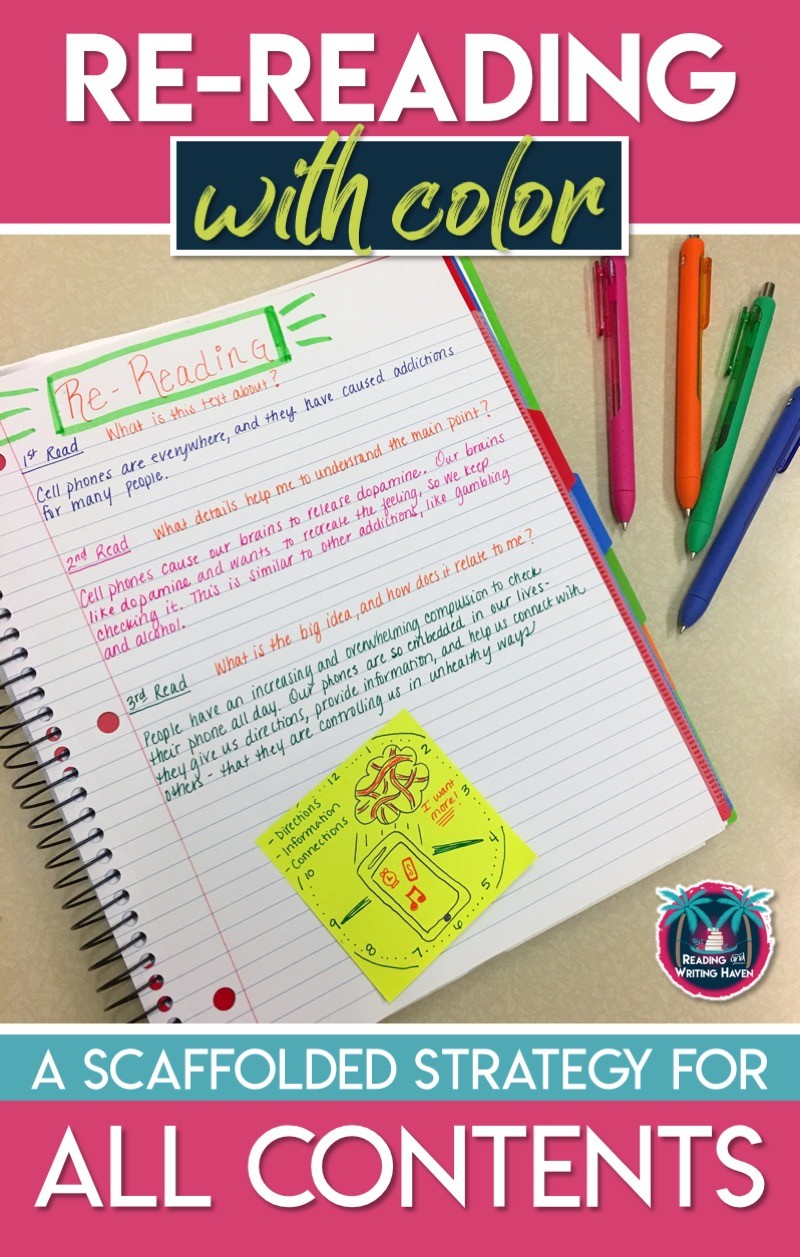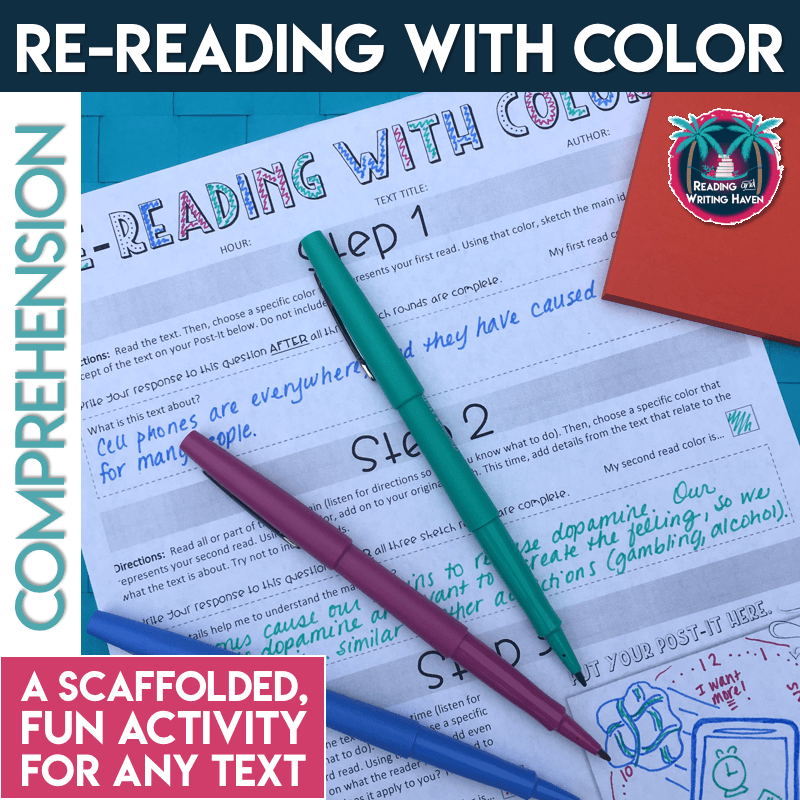Re-Reading with Color: A Reading Strategy for Older Students
There’s a reason why social media is so popular – many reasons, actually. But one of the most important reasons is because it gives us a snapshot into other people’s worlds. As teachers, we desire to have that same snapshot of our students’ thinking when it comes to reading. What I’m writing about in today’s post is a reading strategy to use with older students. It’s short, scaffolded, and flexible. The best part? It will give you a visible glimpse into how your students are processing a text: fiction or nonfiction.
The Strategy
In brief, this strategy requires students to read a text (or just a portion of it) three times. Each time they read the text, they are reading for a different purpose. Here are some possible prompts you could ask students to consider with each round. I suggest only using one question per round, but it doesn’t necessarily have to be these exact questions. Select questions that fit the skill work your students need.
Summarizing:
- 1st Read: What is this text about? (topic)
- 2nd Read: What are some details that help me to understand the central idea? (supporting evidence)
- 3rd Read: What is the big idea, and how does it relate to me? (theme and connections / relevance)
Story Elements:
- 1st Read: What is the setting of the story?
- 2nd Read: What are some specific details that define the setting?
- 3rd Read: How does the setting impact the plot?
Vocabulary:
- 1st Read: What do you think the word means based on context clues and word parts? (Sketch the idea.)
- 2nd Read: Look up the definition in the dictionary. Add details to your sketch based upon the denotation.
- 3rd Read: What is the connotation of the word as it is used in the passage? Add these ideas to your sketch.
Text Structure:
- 1st Read: How does the way the author structures the text make the argument more clear for readers?
- 2nd Read: How does the way the author structures the text make the argument more convincing for readers?
- 3rd Read: How does the way the author structures the text make the argument more engaging for readers?
The best way to create these questions is to analyze the standard you are teaching and break it down into three tasks, from the most basic to the most complex.
Step 1: Sketch
Ask students to read the text one time. Afterward, pose your first question. What is this text about? Students should use a specific color to sketch their thoughts on a Post-It or other piece of paper. You can use this template if you would like something more structured.
Then, ask them to read the text a second time. If applicable, you could ask them to focus their attention on a specific part of the text instead of the whole thing. When they complete their re-reading, have them sketch more details on their Post-It to answer your next question: What are some details that help me to understand the central idea?
Finally, have students read all or part of the text the third time. Again, they will add to their sketch information gleaned from the third read. You can focus their energy with a final question. What is the big idea of this text, and how does it relate to me?
*Tips:
- I recommend having students use different colored writing utensils each time they add more details to their Post-It response. This will be convenient for the written response portion.
- Limit the number of words students can include on their Post-It so that they are forced to think about how to represent the concepts more abstractly.
Written Directions
After students complete their color-coded sketches, I recommend asking them to respond to the prompts you established before reading. The written responses don’t have to be lengthy…just long enough so that you can better understand how they are thinking. Check out the image below for an example of this strategy.
You can stop here, or you can use students’ responses as pre-writing to springboard into a lengthier writing assignment. This reading activity could easily be a scaffolded technique for literary or informational text analysis.
The Benefits
The goal is to get students to think more and more deeply about a reading strategy each time they read the article or story. If you are working on summarizing, as in the example above, students move from identifying what the text is about in general to more specific details and then to theme and connections. You could use this strategy in a similar manner to talk about point of view, author’s purpose, text structure, and more.
If you ask students to use a different color pen, colored pencil, or marker each time they read and add details to their Post-It, they will better understand the power of re-reading.
This strategy works well for reluctant and struggling readers because it breaks close reading and annotation down into bite sized pieces. Chunking keeps students engaged and thinking critically for longer periods of time.
Enriching It
If you are working with advanced students or those who need a challenge, try omitting the questions. Just ask them to read the text three times. Each time, explain that you want them to seek a deeper layer of meaning. Then, allow students to create their own questions. Of course, it always helps to model expectations first, especially if you think students will be confused.
One of my philosophies is that it’s good to have a variety of tools in our belt when it comes to teaching reading. The more variety we can offer when we ask students to demonstrate comprehension, the more engaged they will be. Add this strategy to your repertoire when you need a quick and colorful window into how students are processing a text. It may not be an Instagram feed, but it will be enough to keep you entertained as you study their sketches and read their responses.
READ NEXT:
6 Ways to Assess Comprehension without Making Students Hate Reading
Short Story Unit Teaching Ideas
4 Comprehension Strategies for Struggling Readers
RELATED RESOURCE:
Looking for a clear directions page? The one-page activity below will help you to guide students through the process of re-reading with color.


Thank you! The example you included helps a lot! 🙂
Thank you, Tara! I hope your students enjoy the activity.